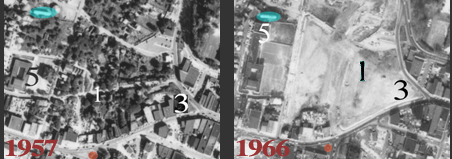Today, the Vinegar Hill Theatre and Vinegar Hill Shopping Center are some of the only landmarks that preserve the name of an historic 20-acre neighborhood, previously located in a triangular area roughly bounded by West Main, Preston, and 4th Street. Up until the 1960s, Vinegar Hill was a thriving African-American community. The eastern edge of the community lies under today’s Omni Hotel (#3 in the photo).

The two photos illustrate the neighborhood before demolition (in 1957) and after (in 1966). The Jefferson School is #5 and #1 indicates the neighborhood itself. For comparison, I have added a red circle (the site of the Lewis & Clark Statue on Main St) and a feature highlighted in light blue in each photo. There are several useful on-line sources that document the history of this neighborhood: an IATH project, Blair Hawkins’ blog on a recent presentation about Vinegar Hill history given by Dr Scot French and Dr Reginald Butler, a UVA site with historic photographs, and a Cavalier Daily article on Vinegar Hill reporting on a play written by Theresa Dowell-Vest. For a slideshow of photos from the neighborhood, visit the Albemarle County Historical Society website.
This post is in honor of new book on the neighborhood, _In the Streets of Vinegar Hill, _written by Mr. James A. Williams, Sr.
P.S. There is no consensus for the origin of the name: Vinegar Hill. Options include: (1) a tannery (that might have used vinegar to tan animals hides); (2) a tribute to the site of a fierce battle during the Irish rebellion of 1798; (3) a reference to bootlegged liquor. Have you heard other explanations ?
